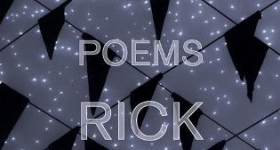For those of you who don't already know: we are in the midst of a
golden age of young adult fiction. The new YA wave -- written for teens aged
12-18 and dealing with coming-of-age issues -- reached the attention of adults
with the onset of Harry Potter mania, and metastasized with the Twilight phenomenon. For over a decade now, publishers and
writers of all stripes have been jumping on the very lucrative bandwagon of a
literature unlimited by age-specific markets, and unhindered by a disgust of
fictional genre.
Hyphen's been looking at the work of Asian American authors in bringing
the concerns of As Am literature into the YA realm,
and there's a lot of it. It's only inevitable that Asian American writers would
quickly reach beyond ethnic-specific narratives into some of the most popular
genres (fantasy, paranormal romance, and, of course, science fiction) filling
the YA sections of your local bookstores.
E.C. Myers' debut novel Fair Coin
is an instructive example of this attempt to bridge -- or perhaps simply
to transcend -- the gap between ethnic YA and speculative YA. In depicting multicultural
characters, while focusing on its plot rather than on cultural issues, Fair Coin is fingering the leading edge of a new trend we've
seen in adult speculative fiction. But does it really succeed in melding
multi-ethnic concerns with genre necessities? (And is that even a goal for its
author?)
Ephraim takes care of his alcoholic single mother, and longs for Jena,
the hot geek girl of his dreams. His best friend Nathan periodically gets
stuffed into lockers, and both generally place their lives on the sucky end of
the teenage scale. Then one day Ephraim comes home from school to find his
mother has attempted suicide. The reason? The cops took her that day to
identify a dead body that looked exactly like Ephraim.
Among the dead boy's effects Ephraim finds a coin; a mysterious note
leads him to flip the coin while making a wish. His experimental wish, that his
mother be okay, comes truer than he could have expected, and he begins to make
more of the wishes that an unhappy teenaged boy would make – including one for
a relationship with Jena. But when the wishes start coming with high price
tags, and Nathan becomes obsessed with the coin, Ephraim starts looking for a
way to stop the madness.

Photo of the author by Monika Webb
To reveal more of the plot would be to spoil it, and we don't do
spoilers here. But I'll give you a spoilerish hint: what starts out as a fairy/morality
tale clearly in the fantasy-YA genre turns, at the mid-point, into a science
fiction story involving advanced technology and multiple universes. While some
may appreciate the shift in genre, others will find it a weakness. The genre
change accompanies a change in the apparent direction and purpose of the novel,
stymie-ing reader expectations of a resolution to the moral quandary Myers has
posed. The second half devolves into a rapid series of episodes that don't
advance character development or make psychological sense; the line-up of
incidents don't mirror the change and growth in the characters' thinking the
way YA -- or traditional coming-of-age or quest tales -- require.
Myers' lack of focus on the characters' cultural backgrounds can also
be seen as either a strength or a weakness. It's always refreshing to see a
multiracial cast sawing away at a plot that doesn't involve social justice
angst. But, while having characters of many colors is a triumph in itself, what
does it avail if they all behave according to mainstream American cultural
dictates? Nathan may or may not be Latino. We have no other clues besides his
last name. And Jena's Asian heritage exists only as a way to make her features
"exotic" (a word actually used to describe her). Given that she's
already a teenage male fantasy, there's an ick-factor to her depiction that
might impact Asian American readers. In a YA field strewn with more
culturally-conscious work, incidental world- and character-building that relies
on cultural specificity really should be a prerequisite.
And our hero? Is never specifically enough described, leaving the
reader to fill-in-ethnicity-here … but let's be honest, in YA as in everything
else, you're white until proven otherwise.
This leaves Fair Coin in fair contention for a
position in the same-old-same-old: white hero/deracinated ethnic sidekicks.
So, a bridge between ethnic coming-of-age and the more popular genre
YA? Not so much, from this seat. But, to be fair, Myers never claimed to be
attempting that span. To judge the book purely on the values it develops for
itself: the first half of Fair Coin flows
with spirit and fun, and -- even after it shifts to a seemingly new genre -- few
readers will have trouble reading it from end to end.
Bottom line? Support a hapa bruddah and buy this book. You'll get a
kick out of it. But be sure to round out your kids' diets with some Malinda Lo, too.
Claire Light is a San Francisco-based writer and cultural worker. You can encounter her at Kearny Street Workshop or the Carl Brandon Society.
To reveal more of the plot would be to spoil it, and we don't do
spoilers here. But I'll give you a spoilerish hint: what starts out as a fairy/morality
tale clearly in the fantasy-YA genre turns, at the mid-point, into a science
fiction story involving advanced technology and multiple universes. While some
may appreciate the shift in genre, others will find it a weakness. The genre
change accompanies a change in the apparent direction and purpose of the novel,
stymie-ing reader expectations of a resolution to the moral quandary Myers has
posed. The second half devolves into a rapid series of episodes that don't
advance character development or make psychological sense; the line-up of
incidents don't mirror the change and growth in the characters' thinking the
way YA – or traditional coming-of-age or quest tales – require.
Myers' lack of focus on the characters' cultural backgrounds can also
be seen as either a strength or a weakness. It's always refreshing to see a
multiracial cast sawing away at a plot that doesn't involve social justice
angst. But, while having characters of many colors is a triumph in itself, what
does it avail if they all behave according to mainstream American cultural
dictates? Nathan may or may not be Latino. We have no other clues besides his
last name. And Jena's Asian heritage exists only as a way to make her features
"exotic" (a word actually used to describe her.) Given that she's
already a teenage male fantasy, there's an ick-factor to her depiction that
might impact Asian American readers. (And shame on[A1] In
mixed-race Asian E.C. Myers for objectifying a sistah!)
a YA field strewn with more culturally-conscious work, incidental world- and
character-building that relies on cultural specificity really should be a
prerequisite.
And our hero? Is never specifically enough described, leaving the
reader to fill-in-ethnicity-here … but let's be honest, in YA as in everything
else, (LINK) you're white until proven otherwise (http://m.newyorker.com/online/blogs/books/2012/03/hunger-games-and-trayvon-martin.html?mbid=social_mobile_FBshare&t=The+Book+Bench%3A+White+Until+Proven+Black%3A+Imagining+Race+in+Hunger+Games+%3A+The+New+Yorker).
This leaves Fair Coin in fair contention for a
position in the same-old-same-old: white hero/deracinated ethnic sidekicks.
So, a bridge between ethnic coming-of-age and the more popular genre
YA? Not so much, from this seat. But, to be fair, Myers never claimed to be
attempting that span. To judge the book purely on the values it develops for
itself: the first half of Fair Coin flows
with spirit and fun, and – even after it shifts to a seemingly new genre – few
readers will have trouble reading it from end to end. The failure of[A2]
further character development in the second half also may not be such a huge
problem, since we got enough at the beginning to help us distinguish the
characters from their (SPOILER!!!) parallel world counterparts later on. And
maybe we'll get to see the characters developed further: a sequel is already in
the works.
Bottom line? Support a hapa bruddah and buy this book. Keep expectations low, and y[A3] You'll get a kick out of it. But
be sure to round out your kids' diets with some Malinda Lo (LINK http://www.malindalo.com/fiction/),
too.
[A1]While
I would never want to rein in your flair for snark, I took this out because
it’s kinda harsh and I’m really not trying to make enemies right now with EC
Myers who kindly contributed to our most recent Issue 25. I think saying there was an “ick-factor” in
the previous sentence gets the point across enough. Adding this deleted sentence just seems to
sprinkle more salt on the wounds.
[A2]Too
much of a spoiler so I took it out.
[A3]Again,
kinda harsh.









Comments